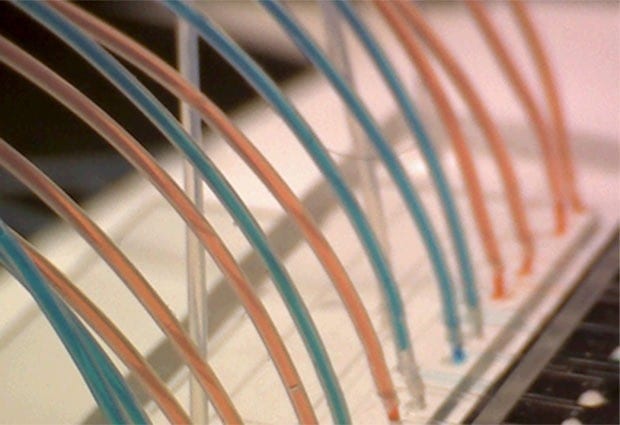
Credit: Wyss Institute at Harvard University
New findings show programmable biomaterials can be delivered using needle injection to induce an immune response and fight deadly diseases
One of the reasons cancer is so deadly is that it can evade attack from the body’s immune system, which allows tumors to flourish and spread. Scientists can try to induce the immune system, known as immunotherapy, to go into attack mode to fight cancer and to build long lasting immune resistance to cancer cells. Now, researchers at the Wyss Institute for Biologically Inspired Engineering at Harvard University and Harvard’s School of Engineering and Applied Sciences (SEAS) show a non–surgical injection of programmable biomaterial that spontaneously assembles in vivo into a 3D structure could fight and even help prevent cancer and also infectious disease such as HIV. Their findings are reported in Nature Biotechnology.
“We can create 3D structures using minimally–invasive delivery to enrich and activate a host’s immune cells to target and attack harmful cells in vivo,” said the study’s senior author David Mooney, Ph.D., who is a Wyss Institute Core Faculty member and the Robert P. Pinkas Professor of Bioengineering at Harvard SEAS.
Tiny biodegradable rod–like structures made from silica, known as mesoporous silica rods (MSRs), can be loaded with biological and chemical drug components and then delivered by needle just underneath the skin. The rods spontaneously assemble at the vaccination site to form a three–dimensional scaffold, like pouring a box of matchsticks into a pile on a table. The porous spaces in the stack of MSRs are large enough to recruit and fill up with dendritic cells, which are “surveillance” cells that monitor the body and trigger an immune response when a harmful presence is detected.
“Nano–sized mesoporous silica particles have already been established as useful for manipulating individual cells from the inside, but this is the first time that larger particles, in the micron–sized range, are used to create a 3D in vivo scaffold that can recruit and attract tens of millions of immune cells,” said co-lead author Jaeyun Kim, Ph.D., an Assistant Professor of Chemical Engineering at Sungkyunkwan University and a former Wyss Institute Postdoctoral Fellow.
Synthesized in the lab, the MSRs are built with small holes, known as nanopores, inside. The nanopores can be filled with specific cytokines, oligonucleotides, large protein antigens, or any variety of drugs of interest to allow a vast number of possible combinations to treat a range of infections.
“Although right now we are focusing on developing a cancer vaccine, in the future we could be able to manipulate which type of dendritic cells or other types of immune cells are recruited to the 3D scaffold by using different kinds of cytokines released from the MSRs,” said co-lead author Aileen Li, a graduate student pursuing her Ph.D. in bioengineering at Harvard SEAS. “By tuning the surface properties and pore size of the MSRs, and therefore controlling the introduction and release of various proteins and drugs, we can manipulate the immune system to treat multiple diseases.”
The Latest on: Injectable 3D vaccines
[google_news title=”” keyword=”Injectable 3D vaccines” num_posts=”10″ blurb_length=”0″ show_thumb=”left”]
via Google News
The Latest on: Injectable 3D vaccines
- Biomaterial Vaccine Boosts Lymph Node Expansion, Enhancing Immunityon May 7, 2024 at 10:45 am
Paulson School of Engineering and Applied Sciences (SEAS), and Genentech, a member of the Roche Group, found a way to enhance and extend LN expansion, and study how this phenomenon affects both the ...
- Biomaterial vaccine enhances lymph node expansion following vaccination, boosting anti-tumor immunityon May 6, 2024 at 6:51 am
But they hadn't yet investigated how their vaccines and those developed by others could influence the response of LNs draining leaked tissue fluid at vaccine injection sites ... to tumors and form a ...
- Expanding a lymph node, boosting a vaccineon May 6, 2024 at 2:41 am
For the first time, researchers from the Wyss Institute for Biologically Inspired Engineering at Harvard University, Harvard John A. Paulson School of Engineering and Applied Sciences (SEAS), ...
- Large Injection Site Reactions After a Second Dose of Varicella Vaccineon May 2, 2024 at 5:00 pm
and erythema at the injection site 24 hours after receiving a second dose of monovalent varicella vaccine. During this same time period, the clinic administered 143 doses of MMRV vaccine and 729 ...
- Corning Life Scienceson April 18, 2024 at 6:53 pm
SGD Pharma, announces its new range of high-quality Type I injectable vials in tubular glass with the added ... handling tips and expert advice to maximize your work in both 2D and 3D cultures with ...
- Vaccine breakthrough means no more chasing strainson April 14, 2024 at 5:00 pm
With one vaccine injection, they found the mice were protected from a lethal dose of the unmodified virus for at least 90 days. Note that some studies show nine mouse days are roughly equivalent ...
- Toward A Universal Covid Vaccineon April 10, 2024 at 9:54 am
The continued evolution of SARS-CoV-2 into new variants, each as or more infectious than the last, underscores the ongoing need to update our vaccine defenses against the virus. While updated ...
- COVID-19 vaccines for kids: What you need to knowon April 1, 2024 at 5:54 am
More children reported these side effects, except for injection site pain, after the second dose of the vaccine. However, some people have no side effects. It isn't recommended that you give your ...
- Large Injection Site Reactions After a Second Dose of Varicella Vaccineon March 22, 2024 at 5:00 pm
A 10-year-old boy presented to the clinic with a chief complaint of a reaction on his leg 2 days after receiving a single subcutaneous dose of varicella vaccine in the left thigh (different ...
- What to Know About Vaccines and ‘Herd Immunity’on September 20, 2023 at 6:27 pm
Want to protect other people? You don't need a black belt or superpowers. Just get the vaccines your doctor recommends for you. A vaccine dramatically lowers your chances of catching and spreading ...
via Bing News










